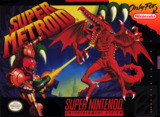Take out anything frustrating from the first two Metroid titles, enhance the depth, and you instantly get Super Metroid.
The story follows after the events of Metroid II. Samus receives a distress signal from the Ceres Space Colony just moments after putting a baby Metroid in the hands of the colony's scientists. All of the scientists are killed off by none other than Samus' long standing arch-nemesis Ridley. Ridley escapes with the baby Metroid and Samus instantly gives chase. She follows the dragon-like fiend back to familiar territory, Planet Zebes.
Super Metroid's gameplay style is similar to that of the first two games, particularly the original Metroid, but this time around there are much welcomed enhancements. You are set all alone on this hazardous planet and you will need to explore it's massive caverns in search of equipment to allow you to explore further and much more easily, as well as fighting off various foes. Exploration and isolation are what make the Metroid series so unique, and Super Metroid pretty much perfects it in that sense. The game rewards your explorations by giving you new weapons to make yourself feel more empowered, and a great sense of accomplishment is felt when you can finally make it past that one area or grab that ever important missile expansion you simply couldn't get before. Along your journey you come across a variety of unique bosses, including one of the best final bosses from the 16-bit era.
While you are not told where to go, you are given a map to keep track of your progress more easily. Once you find a map room, you will be able to know how large an area is, as well as the general idea of where hidden items may be (though where you actually do find them is up to you). But perhaps the game's biggest and best change is the controls. Before, Samus could only shoot left, right, and straight up (and down in Metroid ll). These limits in control made certain sections and enemy placements more frustrating than it needed to be. But now Samus is able to shoot in all eight directions, allowing you to finally take down ground enemies without being limited to bombs, and even a wall jump maneuver. It's also nice to point out that the game even includes save rooms and refill stations.
To go along with the previously mentioned features come a wider selection of items. Returning weapons include the morph ball, morph ball bombs, missiles, the ice beam, the wave beam, the varia suit, high jump boots, and the screw attack, as well as missile expansions, health expansions, and health and missile pick-ups from defeated enemies. New to Samus's arsenal include the charge beam, the Spazer beam (allowing for wide shots), super missiles (five missiles in one), power bombs, a grapple hook, an x-ray scope (allowing you to see through breakable objects), the speed booster (to move quickly and break through walls), and a gravity suit (for added defense and allowing you to travel underwater more easily).
The first thing you will most likely recognize in Super Metroid is it's visual enhancements. The graphics are fantastic, full of larger, more detailed and colorful environments. The game shows off a greater sense of depth thanks to the stronger hardware, and each environment feels completely different from the last. The music is haunting and engrossing, and the sound effects are just as excellent.
To sum things up:
PROS:
-Excellent graphics
-Great soundtrack and sound effects
-Increased depth offers more rewarding exploration
-Improved controls
-A wide range of items and weapons to discover
-Unique bosses
CONS:
Beginners will most likely complete this game in roughly six hours. Series veterans shouldn't take more than a couple of hours. But no matter how fast one can beat the game, Super Metroid is a game that never seems to become boring each time you play. It certainly feels satisfying to breeze through this game after multiple playthroughs, and the game certainly guarantees plenty of replay value. This is easily on of the best games in the SNES library and it is one of Nintendo's greatest achievements.

